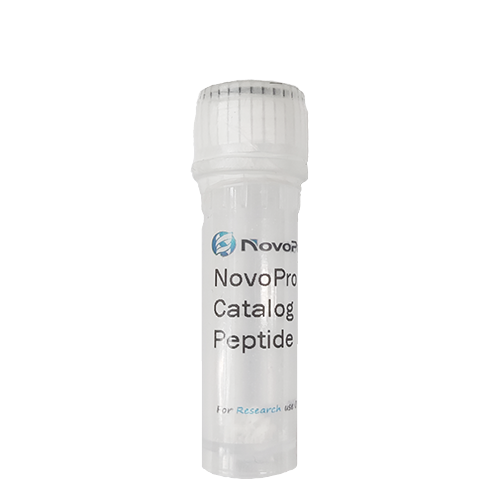-
Product Name
Sermorelin peptide (TFA removed)
-
Documents
Batch to batch variation of the purity
-
Sequence Shortening
YADAIFTNSYRKVLGQLSARKLLQDIMSR-NH2
-
Sequence
H-Tyr-Ala-Asp-Ala-Ile-Phe-Thr-Asn-Ser-Tyr-Arg-Lys-Val-Leu-Gly-Gln-Leu-Ser-Ala-Arg-Lys-Leu-Leu-Gln-Asp-Ile-Met-Ser-Arg-NH2
-
Length (aa)
29
-
Peptide Purity (HPLC)
98.59%
-
Molecular Formula
C149H246N44O42
-
Molecular Weight
3357.88
-
Source
Synthetic
-
Form
Powder
-
Description
Sermorelin is also named: Sermorelin Acetate. CAS NO.: 86168-78-7. Sermorelin Acetate, also known as GRF 1-29, is a Growth Hormone Releasing Hormone (GHRH) produced by the brain that stimulates the production and release of Growth Hormone (GH). Sermorelin Acetate was first developed in the 70s, which is thought to be the shortest fully functional fragment of GHRH and has been used as a test for Growth Hormone secretion. It is often used extensively in Anti-aging Therapy along with Testosterone in men. Sermorelin Acetate affects a more primary source of failure in the GH neuroendocrine axis, has more physiological activity, and its use for adult hormone deficiency is not restricted. Compared to human Growth Hormone (hGH), Sermorelin Acetate is a growth hormone secretagogue, which means that it stimulates the pituitary gland to produce and secrete growth hormone. Also, Sermorelin Acetate and Modified GRF 1-29 contains 29 amino acids whereas hGH is a larger molecule containing 191 amino acids.
-
Storage Guidelines
Normally, this peptide will be delivered in lyophilized form and should be stored in a freezer at or below -20 °C. For more details, please refer to the manual:Handling and Storage of Synthetic Peptides
-
References
- Walker RF. Sermorelin: a better approach to management of adult-onset growth hormone insufficiency?. Clin Interv Aging. 2006;1(4):307-8.
-
About TFA salt
Trifluoroacetic acid (TFA) has a significant impact on peptides due to its role in the peptide synthesis process.
TFA is essential for the protonation of peptides that lack basic amino acids such as Arginine (Arg), Histidine (His), and Lysine (Lys), or ones that have blocked N-termini. As a result, peptides often contain TFA salts in the final product.
TFA residues, when present in custom peptides, can cause unpredictable fluctuations in experimental data. At a nanomolar (nM) level, TFA can influence cell experiments, hindering cell growth at low concentrations (as low as 10 nM) and promoting it at higher doses (0.5–7.0 mM). It can also serve as an allosteric regulator on the GlyR of glycine receptors, thereby increasing receptor activity at lower glycine concentrations.
In an in vivo setting, TFA can trifluoroacetylate amino groups in proteins and phospholipids, inducing potentially unwanted antibody responses. Moreover, TFA can impact structure studies as it affects spectrum absorption.
-
Molar Concentration Calculator
-
Dilution Calculator
-
Percent Concentration Calculator
Mass (g) = Concentration (mol/L) × Volume (L) × Molecular Weight (g/mol)
Related Products / Services
• Peptide Services: NovoPro's peptide synthesis services include standard chemical peptide synthesis, peptide modification, peptide libraries, and recombinant peptide expression.
• Standard Peptide Synthesis: NovoPro offers quality peptides at the most competitive prices in the industry, starting at $3.20 per amino acid. NovoPro provides PepBox – Automatic Quote Tool for online price calculation.
• Peptide Modifications: NovoPro offers a wide range of peptide modification services including isotope labeling (2H, 15N, and 13C), multiple disulfide bonds, multiple phosphorylations, KLH, BSA, ovalbumin, amidation, acetylation, biotin, FITC, etc.
Please note: All products are "FOR RESEARCH USE ONLY AND ARE NOT INTENDED FOR DIAGNOSTIC OR THERAPEUTIC USE"

